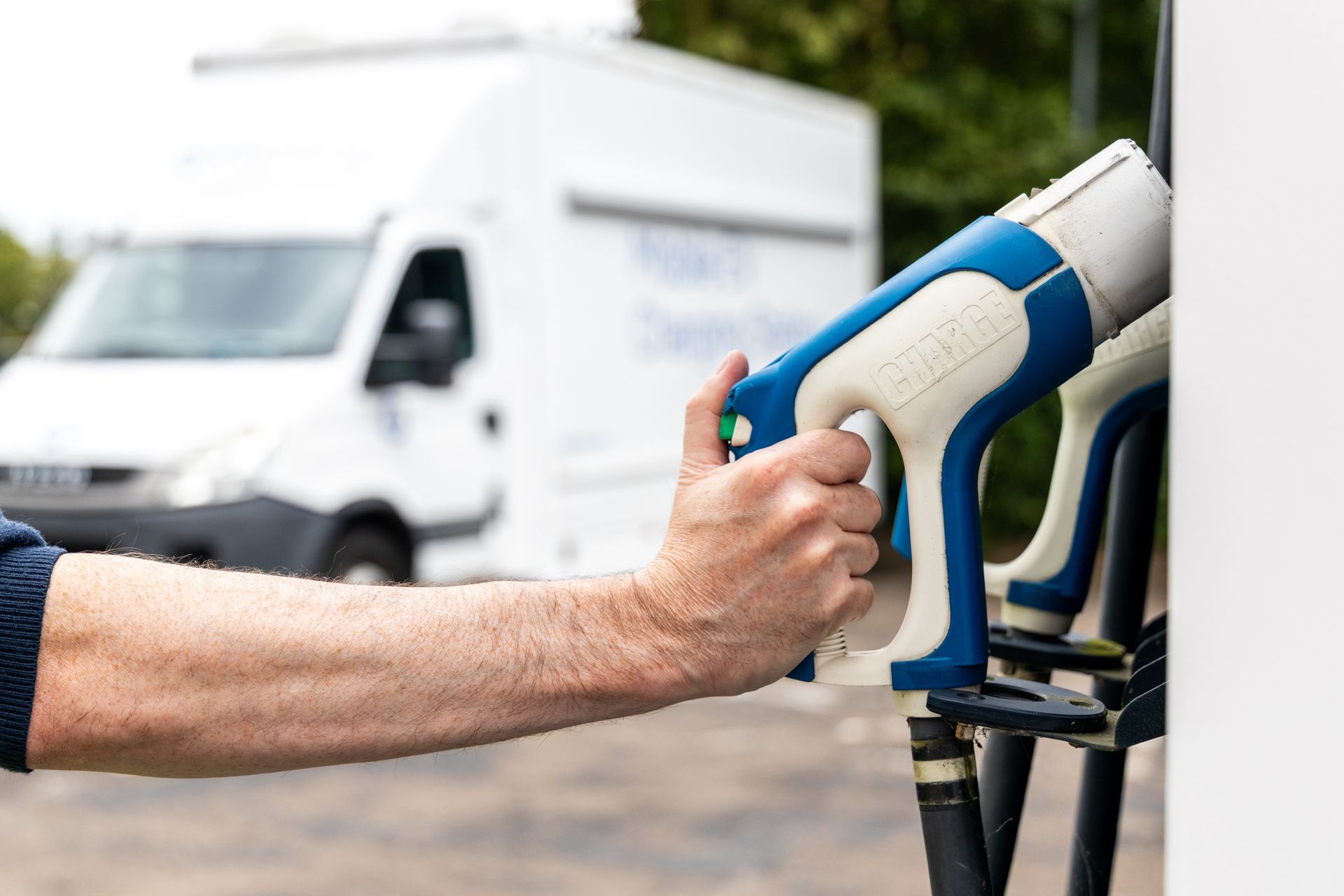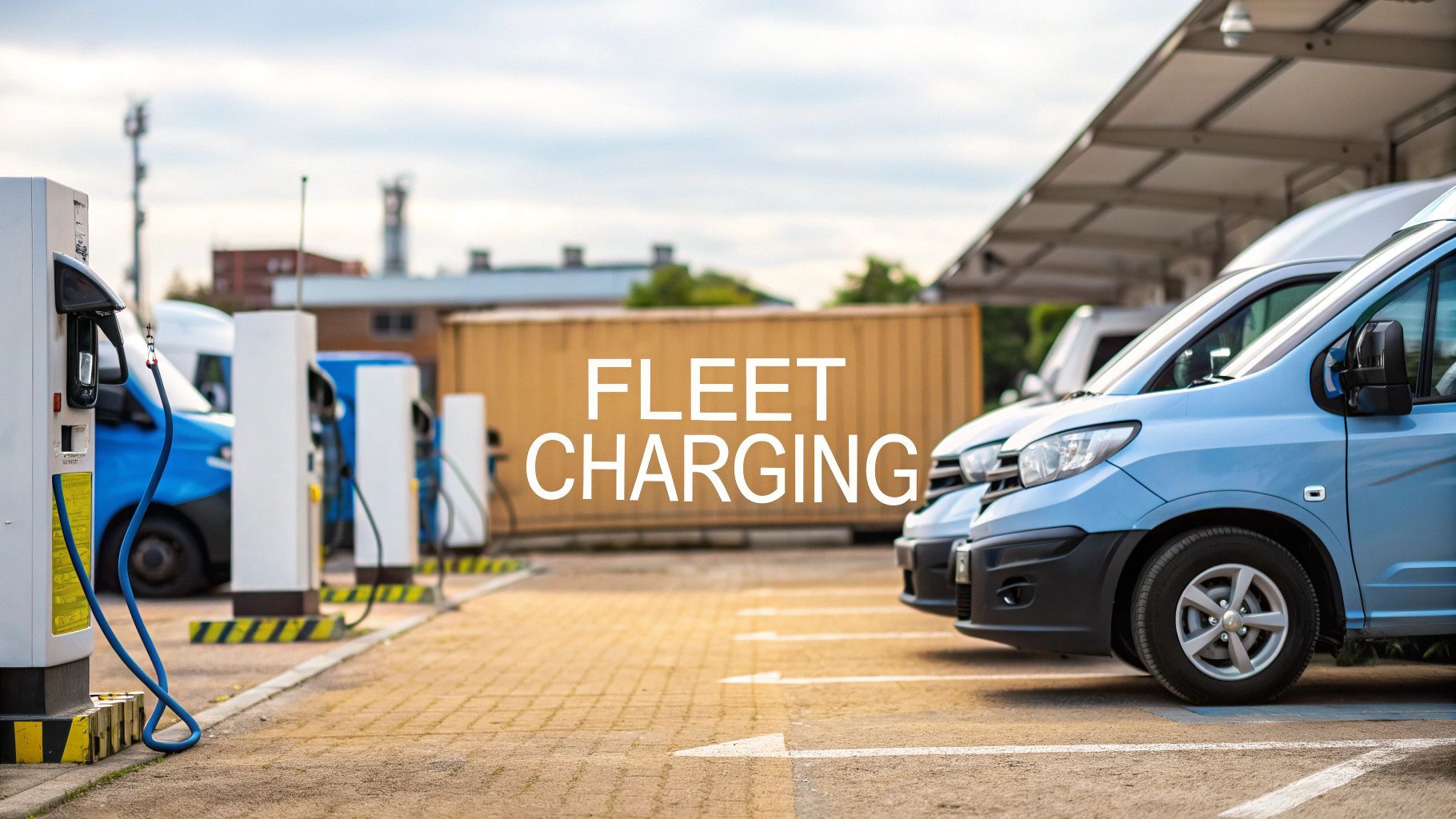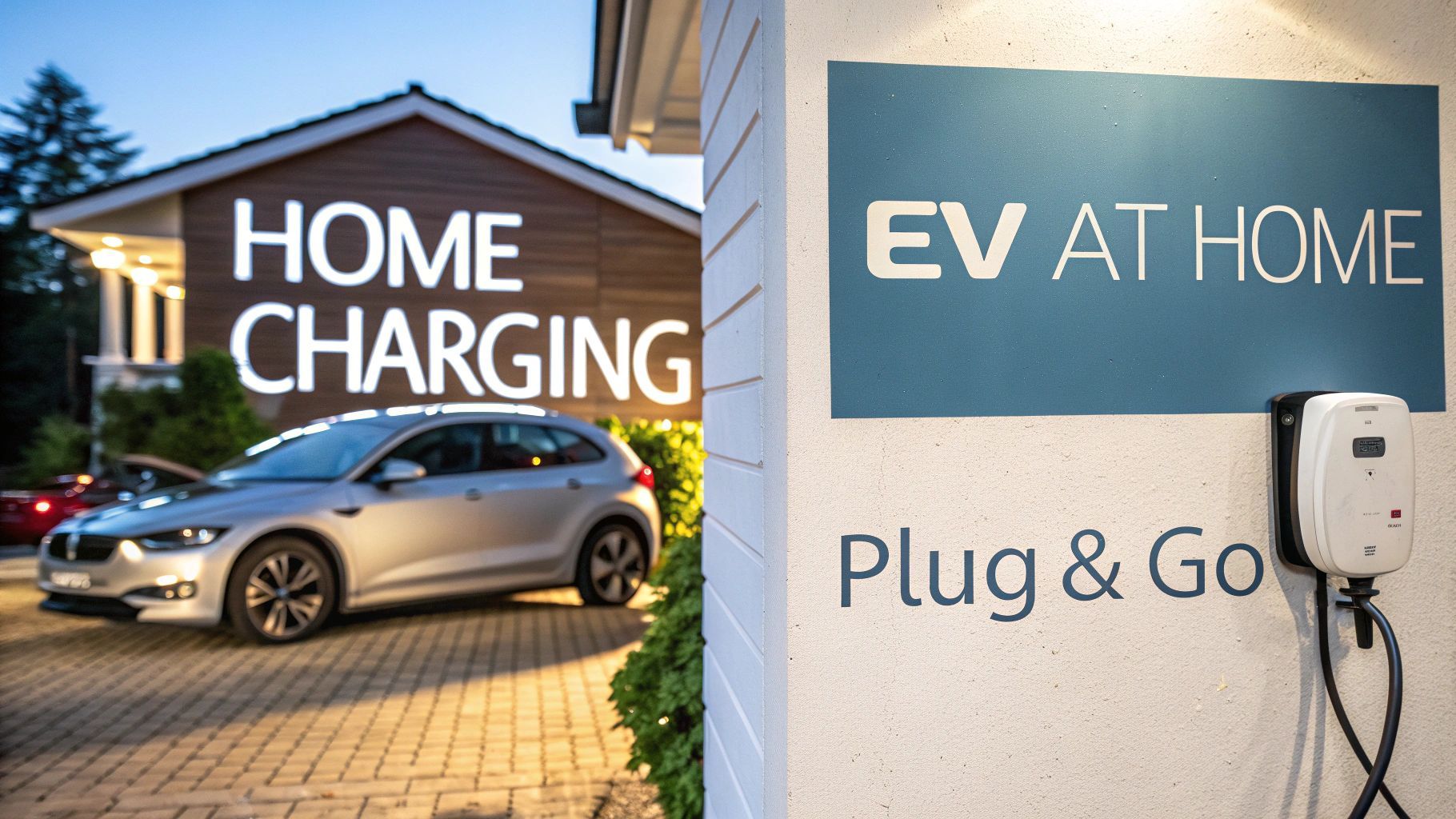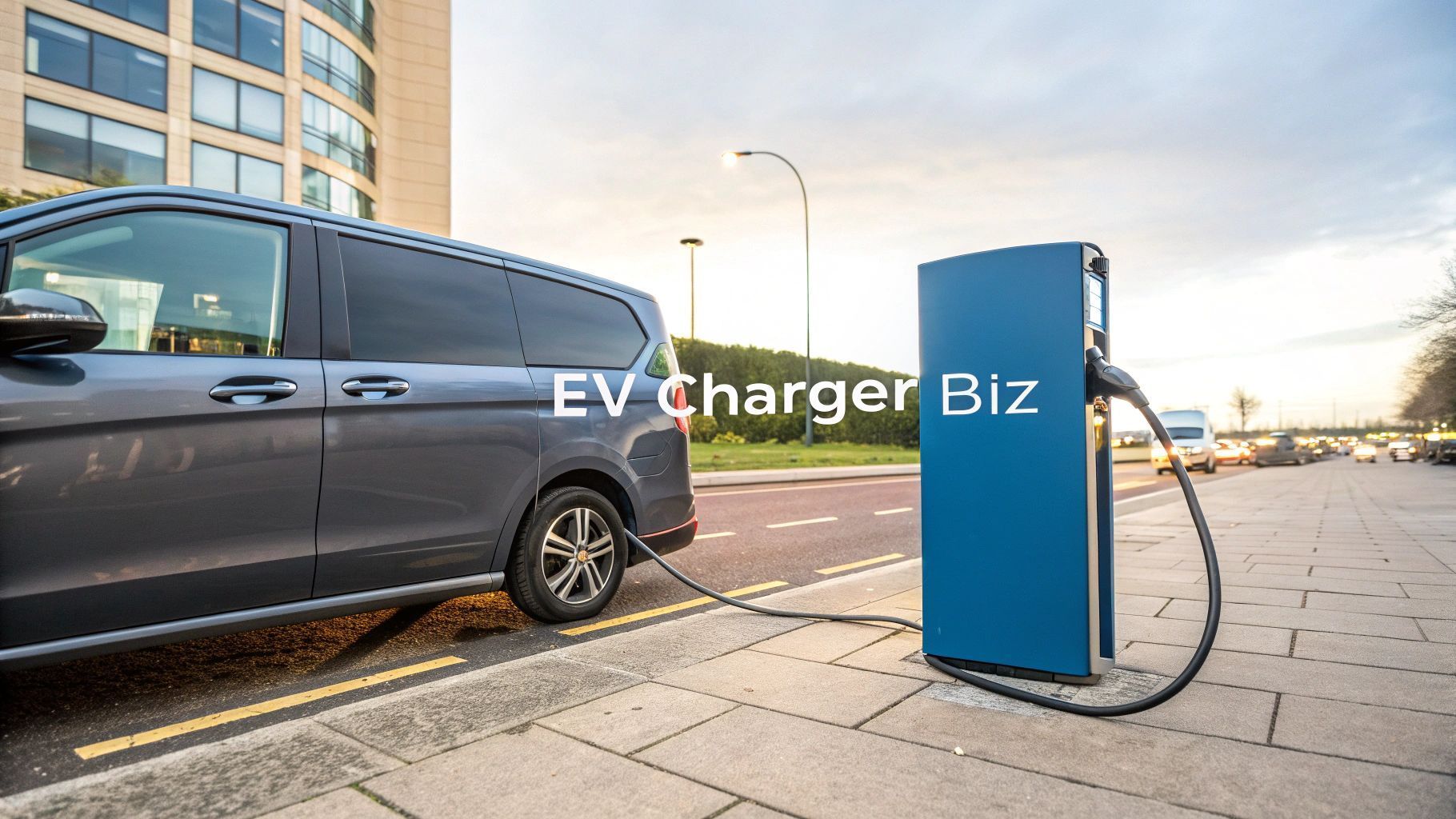A Complete Guide to Every EV Charging Plug
Staring at a wall of different sockets and cables can feel a bit like trying to plug a UK kettle into a European socket – confusing and a little frustrating. But getting to grips with the world of EV charging plugs is the first step to feeling confident as an electric vehicle owner. This guide will walk you through the different connectors you will find across the UK, from the one you will use at home to the high-powered ones at motorway service stations.
Once you know your plugs, you can stop worrying about running out of juice and start planning your routes with confidence.
Why Understanding Your EV Charging Plug Matters
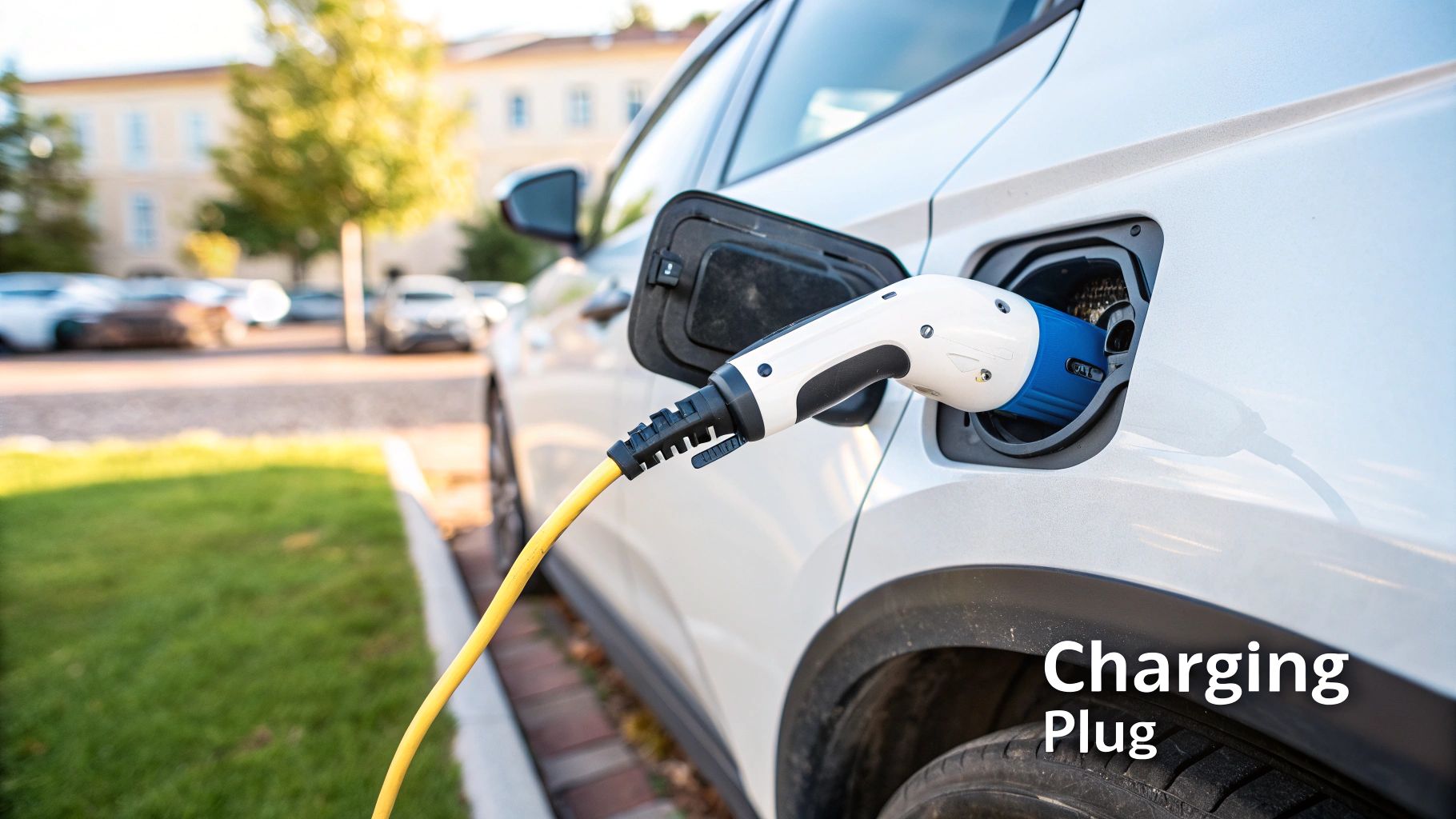
When you switch to an electric car, the familiar petrol pump is replaced by an EV charging plug . The catch is, they are not all the same. Knowing which one your car needs is crucial for a hassle-free experience, saving you the headache of pulling up to a charger only to find it will not fit. Think of it as your first line of defence against range anxiety.
It is really no different from knowing your phone needs a USB-C cable instead of an old Lightning one. You simply need the right connection to get power. For EVs here in the UK, you will mostly come across a few key types of plugs, each built for a different job and charging speed.
AC vs DC Charging: A Simple Analogy
The two main ways to charge your EV boil down to two types of electricity: Alternating Current (AC) and Direct Current (DC). It sounds technical but the difference is easy to grasp and explains why different plugs exist.
Let’s imagine your car's battery is a bucket you need to fill with water.
-
AC Charging: This is like using your garden hose. It gives you a steady, reliable flow that is perfect for filling the bucket overnight. AC is the standard electricity supplied to our homes and your car has an on-board charger that converts it into DC power to store in the battery.
-
DC Charging: This is the fire hose. It delivers a massive, direct blast of water to fill the bucket in minutes. DC rapid chargers bypass your car's little on-board converter and pump power straight into the battery, making them ideal for quick top-ups on long journeys.
An EV's on-board charger sets the limit for its AC charging speed, which is usually between 7kW and 22kW . In contrast, DC rapid chargers can deliver anywhere from 50kW to over 350kW , cutting charging times from hours down to just minutes.
The Growing UK Charging Network
You can see this AC/DC split reflected in the UK's public charging infrastructure, which is growing at a fantastic pace. As of April 2025, the UK had 76,507 public charging devices .
The majority of these are slower AC chargers, which you will find in places like supermarket car parks and leisure centres. Around 20% are the powerful 50kW+ DC rapid chargers you see at motorway services, which are essential for long-distance travel. This mix gives drivers plenty of options, from convenient top-ups during the weekly shop to lightning-fast charges on a road trip. You can dive deeper into the official numbers with the latest UK charging statistics on GOV.UK.
Your Guide to UK EV Charging Plugs
Figuring out electric vehicle plugs can feel a bit like learning a new language at first. But trust me, it is much simpler than it looks. Once you get your head around the main types you will find in the UK, you will be able to pull up to any charging station with confidence.
The great news is that things have become much more standardised for modern cars, making life a lot easier for all of us. This guide will walk you through the key players: the everyday Type 2 plug and the high-speed CCS and CHAdeMO connectors for when you need a rapid top-up. Get these three sorted and you have basically cracked the UK charging network.
This diagram gives you a quick visual breakdown of the plugs you will come across.
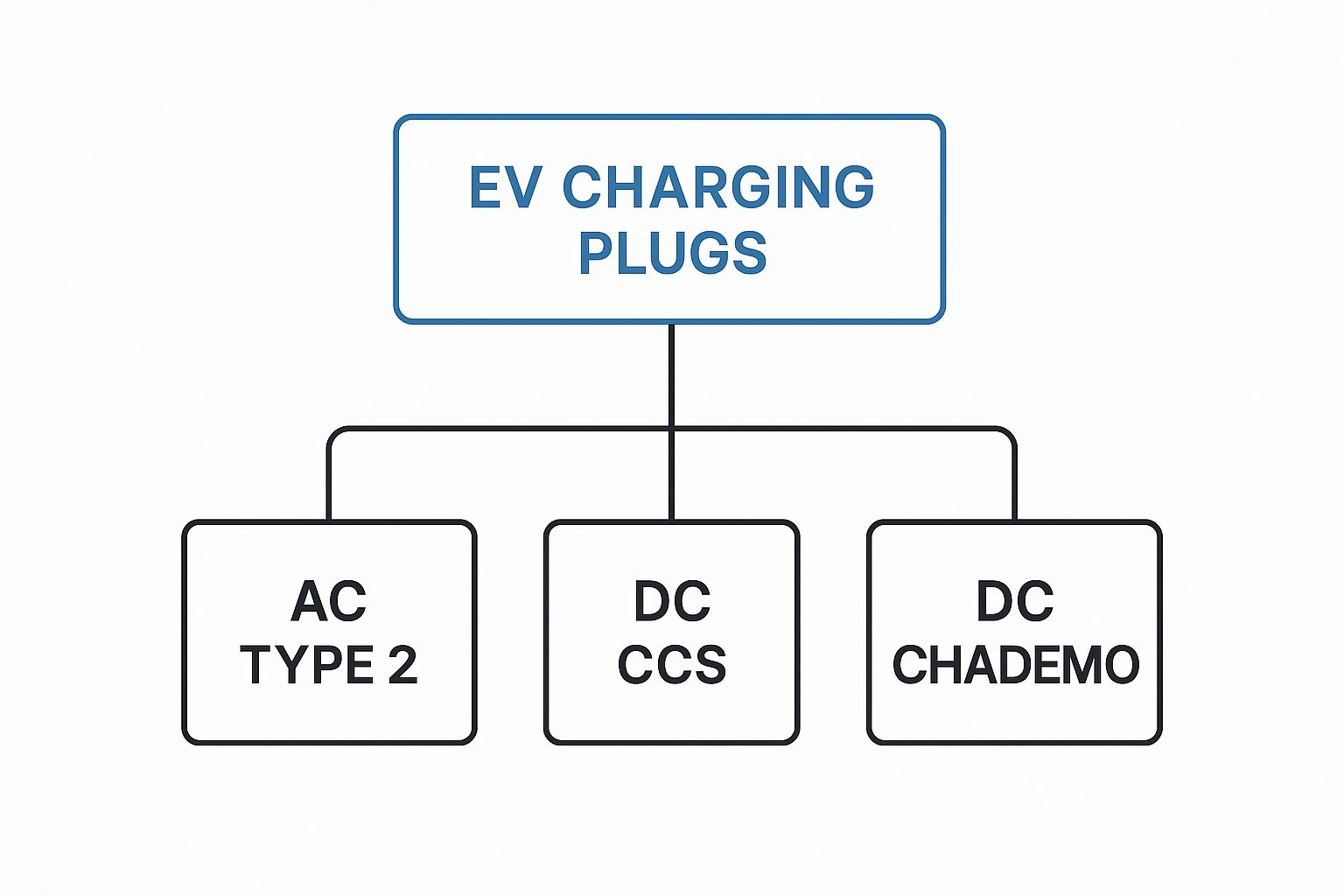
As you can see, the biggest difference comes down to whether they supply slower AC power or much faster DC power. Grasping that distinction is the most important first step for any EV driver.
Type 2: The Go-To Plug for Everyday Charging
If you drive an EV in the UK or Europe, think of the Type 2 connector as your new best friend. It is now the mandatory standard for all new electric cars sold here, which is why it is the plug you will see more than any other.
You will find Type 2 sockets on home wallboxes and at pretty much every public AC charging point – from the local supermarket to city-centre car parks. It is a really versatile connector. Depending on your car's on-board charger, it can deliver anything from a slow 3.7kW trickle (often from a three-pin plug adaptor) right up to a speedy 22kW at public stations.
- Best for: Home charging and public "destination" chargers (e.g., at work, the gym, or shopping centres).
- Typical Power: Usually 7kW for home units and up to 22kW for public posts.
- Used by: All new electric cars in the UK and Europe, including brands like Tesla, Volkswagen, BMW and Hyundai.
The dominance of the Type 2 plug has genuinely simplified public charging. You can pull into most AC charge points feeling certain that the socket will fit your car.
CCS (Combined Charging System): The Fast Lane for DC Power
When you need to get back on the road quickly, you will be looking for a CCS plug . It is the undisputed champion of high-speed charging in the UK and Europe.
The design is brilliant in its simplicity. It is essentially a Type 2 plug with two extra-large pins underneath, which handle the high-power DC current. This "combined" setup means a car with a CCS port can use both standard Type 2 AC chargers and the ultra-rapid DC chargers you find at motorway services.
The CCS plug is the standard for rapid charging across Europe. Power levels typically start at 50kW and can go all the way up to an incredible 350kW . At those top speeds, you can add over 100 miles of range in the time it takes to grab a coffee and stretch your legs.
This makes CCS the go-to for almost all modern European and American EVs. If you have bought a new electric car in the UK recently, it almost certainly uses a CCS port for rapid charging. Knowing what to look for is key and you can dive deeper into how to check for EV charging compatibility between different cars and chargers.
CHAdeMO: The Original Rapid Charger
Before CCS took the crown, CHAdeMO was the trailblazer in DC rapid charging. The name is a bit of a mouthful but it is an abbreviation of "CHArge de MOve," which roughly translates from Japanese to "charge for moving."
Developed in Japan, this standard is mainly found on slightly older Japanese models, most notably the Nissan Leaf and the Mitsubishi Outlander PHEV. While CHAdeMO chargers are still a common sight across the UK, new car models are no longer being built with this port as the industry has shifted decisively towards CCS.
- Best for: Rapid DC charging, primarily for older Japanese vehicles.
- Typical Power: Most often 50kW , though some newer units can go higher.
- Used by: Most famously, the Nissan Leaf, alongside other models from Mitsubishi.
Even though it is being phased out on new cars, the thousands of CHAdeMO-compatible vehicles on the road mean you will still find these connectors at charging hubs for years to come. For new car buyers, though, the future is clearly CCS.
UK EV Charging Plug Comparison
To help you visualise how these plugs stack up, here's a quick side-by-side comparison of the connectors you will encounter most often in the UK.
| Plug Type | Common Use | Power Output (kW) | Typical Charge Time | Common Car Brands |
|---|---|---|---|---|
| Type 2 | Home & Public AC (slow/fast) | 3.7kW - 22kW | 3-12 hours | All new cars (Tesla, VW, BMW, Hyundai) |
| CCS | Public DC (rapid/ultra-rapid) | 50kW - 350kW | 20-60 minutes | Most new cars (VW, Ford, BMW, Hyundai, Kia) |
| CHAdeMO | Public DC (rapid) | ~50kW | 30-60 minutes | Nissan Leaf, Mitsubishi Outlander |
This table simplifies the main differences in power and use case, helping you identify which plug you need for any given situation, whether you are charging overnight at home or grabbing a quick boost on the motorway.
The Untapped Business of Mobile EV Charging
While we see more and more fixed charging points popping up, they are only one piece of the puzzle. There is a massive opportunity hiding in plain sight with a much more flexible solution: mobile EV charging. Think of it as turning a vehicle into a power bank on wheels, ready to deliver a vital service wherever and whenever it is needed most. This flexibility is not just convenient; it is the foundation of a highly profitable business model.
Mobile charging fills the gaps that a fixed infrastructure just cannot. It is the perfect answer to every EV driver's worst fear—getting stranded with a dead battery miles from a working charger. For an operator, this service is so much more than roadside recovery; it is a high-margin business model built on convenience and necessity.
The concept could not be simpler. You equip a van with a powerful battery unit and the right cables to connect to any EV. This setup lets you bring the charge directly to a stranded driver, a commercial fleet, or even a pop-up event, turning someone else’s downtime into your profitable transaction.
Lucrative Revenue from Emergency Call-Outs
The most obvious and profitable service you can offer is emergency roadside assistance. When an EV driver runs out of juice, they are in a real bind. You cannot just bring them a can of electricity like you can with a petrol car. They need a specialised power source and they need it now.
This is where a mobile charging service becomes an absolute lifesaver. Because the need is so urgent, operators can command premium fees. It is not at all unusual for emergency call-out charges to top £100 per hour , factoring in travel time and the energy itself. A single call can be a very tidy earner.
What makes this model so successful is that you are not just selling electricity. You are selling a solution to a stressful, trip-ruining problem. You are selling peace of mind.
Building Predictable Income with Fleet Contracts
Beyond the one-off emergency calls, mobile charging is your key to unlocking recurring revenue through commercial fleet contracts. Countless businesses are switching their vans and company cars to electric but many do not have the space, capital, or desire to install a whole bank of chargers at their depot.
This is a gap you can fill perfectly. As a mobile charging operator, you can offer a subscription-based service, swinging by a client's yard during off-peak hours to top up their entire fleet. For the client, the benefits are huge:
- No Upfront Infrastructure Costs: They get to avoid the huge expense and disruption of installing their own fixed chargers.
- Operational Efficiency: All their vehicles start the day with a full battery, meaning drivers are not wasting time at public charge points.
- Total Flexibility: The service can easily be scaled up or down as their fleet grows or their needs change.
For you, this creates a wonderfully steady and predictable income stream. Landing just a handful of fleet contracts can provide a solid financial foundation, transforming your business from a reactive emergency service into a proactive energy partner.
Imagine a small delivery firm with ten electric vans. A mobile operator could secure a contract to charge these vehicles three times a week overnight. This arrangement provides consistent work and builds a long-term business relationship, insulating the operator from the fluctuating demand of public call-outs.
Capitalising on 'Charging Deserts' and Events
Another fantastic market is providing power in what are often called 'charging deserts'—areas with few, if any, public charge points. Think rural villages, holiday parks and even new housing estates that often lack proper infrastructure. A mobile unit can function as a pop-up charging hub, delivering a desperately needed service and generating great income.
In the same way, temporary events are a golden opportunity. Festivals, outdoor markets and corporate functions are perfect scenarios where organisers can hire a mobile charging service for attendees and staff. This can be a very lucrative contract, whether you charge a flat day rate or a per-charge fee.
By pinpointing these underserved locations and temporary needs, an operator can turn their mobile unit into an essential utility. The freedom to go where the demand is gives mobile charging a powerful edge over fixed installations. It is a business that can adapt in real-time, turning a van, a battery and the right EV charging plug into a profitable and sought-after enterprise.
Navigating Regional Charging Infrastructure Differences
Knowing which charging plug your car uses is one thing but actually finding a compatible charging point when you need it is a whole different challenge. In the UK, the availability of public chargers can feel like a real postcode lottery and your experience can change dramatically from one county to the next.
This geographical divide is most obvious when you compare bustling cities with more remote, rural spots. Big urban centres are often packed with charging options but head out into the countryside and you might find yourself in a "charging desert" where a bit of forward planning is essential. Getting your head around this landscape is the key to a stress-free life with an EV.
The Urban and Rural Divide
The contrast between regions is stark. Some areas are brilliantly equipped, while others are lagging far behind. It all comes down to things like population density, local council investment and just how quickly people in the area have started switching to electric. And of course, your personal setup matters too; things like the cost of installing a home EV charger play a big part in the overall picture.
Take Greater London, for example. As of July 2025, it is the undisputed leader with over 25,502 public charging devices —that is about 30% of all the public chargers in the entire country. To put that in perspective, the capital has more than double the number of chargers than the next best region, the South East.
The density is also in a league of its own. London boasts an incredible 263 chargers for every 100,000 people , which is more than twice the national average. Now, compare that to Northern Ireland, which has just 707 devices in total. That works out to a mere 35 chargers per 100,000 people , highlighting the huge gap drivers there have to deal with.
This disparity means a driver in London can often find a charger just around the corner, while someone in a rural part of Northern Ireland might have to drive for miles to find the nearest compatible plug.
Tools for Stress-Free Journeys
This uneven spread does not have to ruin long-distance travel, though. It just means you need the right tools in your toolkit. Thankfully, there is a great selection of apps and in-car navigation systems that make planning your route and finding chargers a breeze.
Good journey planning is what turns range anxiety into simple, predictable logistics. The best apps let you filter your search for chargers based on what you need:
- Plug Type: Find exactly the right connector, whether it is Type 2, CCS, or CHAdeMO.
- Network Provider: Stick to the networks you are subscribed to and avoid unexpected costs.
- Power Level: Look for rapid DC chargers for a quick boost or slower AC points for an overnight stop.
- Live Availability: Check in real-time if a charger is free, in use, or out of order before you even get there.
Using these tools, you can map out a reliable route with charging stops you can count on. For a deeper dive into the different networks, you can read our guide on understanding the UK’s public EV charging point networks in 2025. A little preparation goes a long way, ensuring you can travel anywhere in the UK with complete confidence, knowing you will always find the right plug for your car.
The Future of EV Charging Plugs and Technology
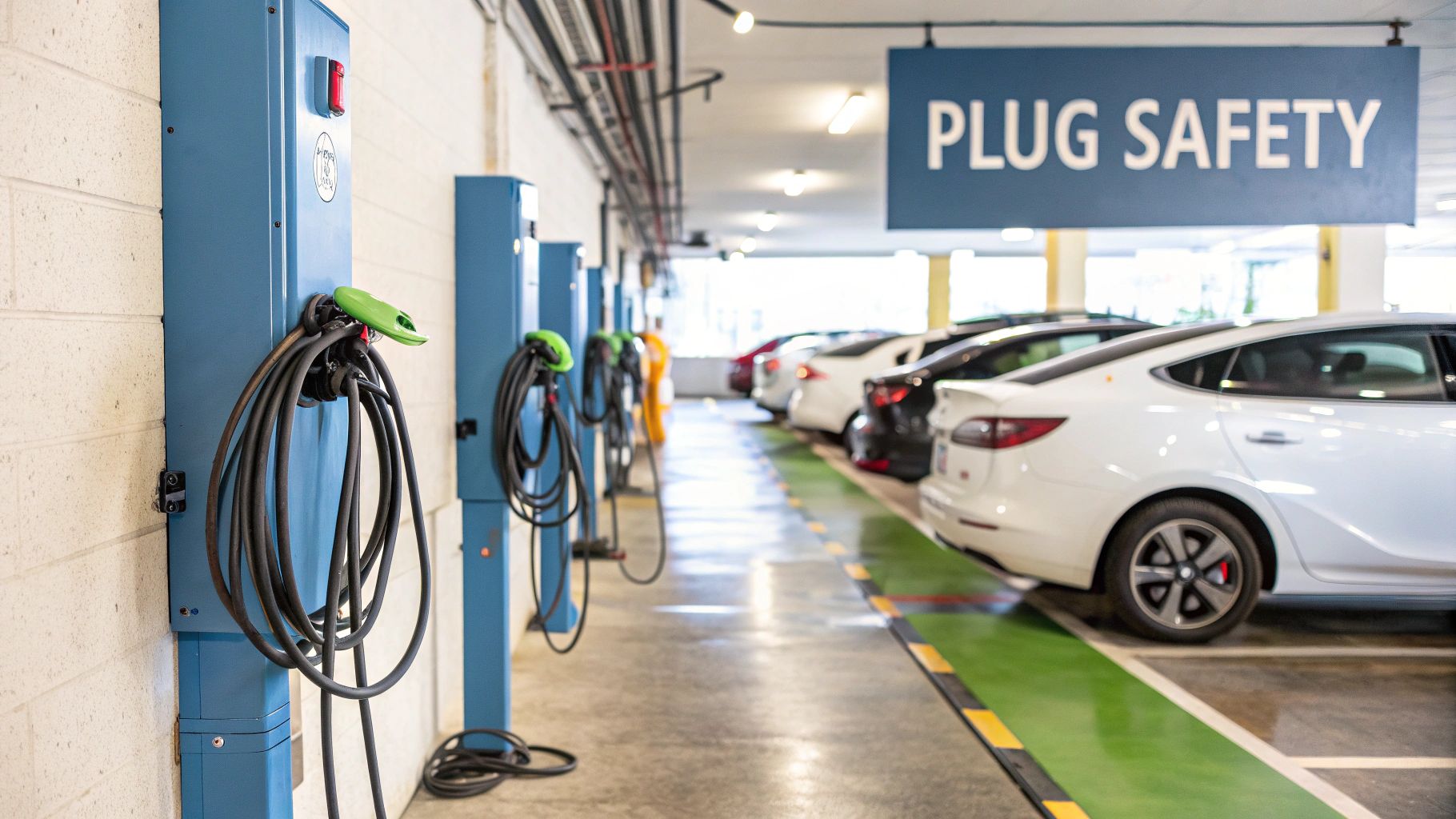
The humble EV charging plug sits right at the centre of the electric vehicle experience and the technology behind it is moving at a breakneck pace. As the UK accelerates towards an all-electric future, the plugs and systems we rely on are getting smarter, faster and more deeply woven into our daily lives. These advancements are steadily making EV ownership a simpler and more seamless affair.
One of the biggest shifts we are seeing is a move towards standardisation. The confusing early days of competing plug types are finally giving way to a clear winner, with the CCS (Combined Charging System) plug cementing its place as the go-to standard across the UK and Europe. Almost every new EV now rolls off the production line with a CCS port, meaning drivers can pull up to a rapid charger with far more confidence about compatibility.
This convergence simplifies things for everyone. While older standards like CHAdeMO will still be around for years on the cars we see today, the industry's decisive pivot to CCS allows for a more unified and reliable public charging network.
Beyond Just Charging Your Car
The next major leap forward for the EV charging plug is technology that lets power flow both ways. It is known as bi-directional charging or Vehicle-to-Grid (V2G) and it effectively turns your car into a battery on wheels. With V2G, your car can power your home or even sell electricity back to the grid when it is needed most.
Just imagine this: your car charges up overnight when electricity is cheap. The next evening, during peak hours when energy prices soar, your car could power your lights and appliances, taking a real chunk out of your utility bill. This is not just a gimmick; it has the potential to completely reshape our energy system, transforming millions of EVs into a vast, flexible power network that helps balance supply and demand.
Bi-directional charging could help stabilise the national grid by allowing EVs to discharge power during peak demand, reducing the need for fossil fuel power stations to fire up. It transforms an idle car into a valuable energy asset.
The End of the Cable
Perhaps the most exciting development on the horizon is the gradual arrival of wireless charging. This technology eliminates the EV charging plug entirely. Instead, you would simply park your car over a charging pad embedded in the ground—whether in your garage, a public car park, or even at the kerbside—and the vehicle would start charging automatically.
This is the ultimate in convenience. No more wrestling with heavy, wet cables or fumbling with plugs in the dark. The whole process becomes effortless. While it is still early days for mainstream adoption, the potential for automated, hassle-free charging is immense, particularly for drivers with mobility issues or for those in cities where traditional plug-in points are impractical.
The growth of the EV market and the charging infrastructure that supports it is a huge focus for the UK government, especially with electric vehicles accounting for nearly one in five new car sales in 2024. You can find out more about UK policy and market trends on Gridserve.com.
Your Questions on EV Charging Plugs Answered
Even when you have got a handle on the main plug types, it is completely normal to have a few more questions rattling around. The world of EV charging has its own language and quirks but getting clear answers to common queries is the final step to feeling totally confident on the road. This section tackles those practical, "what if" questions that pop up for new and seasoned EV drivers alike.
Think of this as your go-to FAQ for everything to do with your EV charging plug . We will give you straightforward answers to help you navigate any charging situation without a second thought. For a deeper dive into any specific terms, our comprehensive EV charging glossary is always there to help.
Can I Use an Adaptor for Different Plugs?
The answer is a classic "yes and no," and it is absolutely crucial to know the difference for your own safety. Adaptors are generally fine and quite common for AC charging—think of using a Type 2 cable with an adaptor for a standard three-pin domestic socket to trickle charge at home.
However, you should never attempt to adapt between the big DC rapid charging standards like CCS and CHAdeMO. It is a definite no-go. These systems are built on completely different communication protocols and electrical specifications. Trying to bodge a connection with an unofficial adaptor is not just a waste of time; it is incredibly dangerous and could cause serious damage to both the charging station and your vehicle. When you are rapid charging, always stick to the plug your car was built for.
What Is the Real Difference Between AC and DC Charging?
The simplest way to picture it is to think about where the electricity gets converted. Your EV's battery can only store Direct Current (DC) power but our national grid supplies Alternating Current (AC).
With AC charging , the conversion from AC to DC happens inside your car, handled by its on-board charger. This piece of kit is relatively small and compact, which is why AC charging is slower—perfect for topping up overnight at home or during the day at work.
With DC charging , that conversion process happens outside the car in a great big converter inside the charging station itself. This allows it to bypass your car's smaller on-board unit and pump power directly into the battery at much, much higher speeds.
Essentially, AC charging is a steady, home-cooked meal prepared by your car's kitchen, while DC charging is a high-speed takeaway delivered straight to your battery's front door.
How Do I Find Compatible Chargers for My Car?
Thankfully, guesswork is a thing of the past. Modern apps and in-car systems have made finding the right charger incredibly easy. Tools like Zap-Map, Bonnet, or even your car’s built-in sat-nav are your best friends here.
These platforms let you filter charging stations by specific criteria, so you only see spots that will definitely work for your vehicle. You can easily filter by:
- Plug type: To match your car's socket (e.g., CCS or Type 2).
- Charging speed: To pinpoint rapid chargers for a quick stop-off.
- Network provider: If you want to stick to a specific company.
- Live status: To check if a charger is actually available before you drive there.
When you find yourself in an area without compatible fixed chargers or simply need power delivered directly to you, ZAPME offers a flexible solution. Our mobile charging units bring the power to you, eliminating range anxiety and providing a reliable charge wherever you are. Find out more at https://www.zapme.biz.

